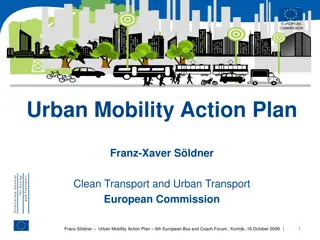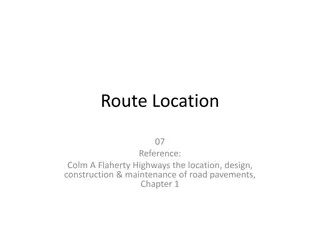Urban Planning and Road Design Guidelines
Explore various road patterns like rectangular, radial, and hexagonal, along with classifications from arterial to local streets. Understand design considerations such as speed limits, access, and spacing for different road types. Learn about factors influencing road alignment and requirements for hill roads.
Download Presentation

Please find below an Image/Link to download the presentation.
The content on the website is provided AS IS for your information and personal use only. It may not be sold, licensed, or shared on other websites without obtaining consent from the author.If you encounter any issues during the download, it is possible that the publisher has removed the file from their server.
You are allowed to download the files provided on this website for personal or commercial use, subject to the condition that they are used lawfully. All files are the property of their respective owners.
The content on the website is provided AS IS for your information and personal use only. It may not be sold, licensed, or shared on other websites without obtaining consent from the author.
E N D
Presentation Transcript
Rectangular or Block patterns Radial or Star block pattern Radial or Star Circular pattern Radial or Star grid pattern Hexagonal Pattern Minimum travel Pattern
ARTERIAL ROADS SUB ARTERIAL COLLECTOR LOCAL STREET CUL-DE-SAC PATHWAY DRIVEWAY
No frontage access, no standing vehicle, very little cross traffic. Design Speed : 80km/hr Land width : 50 60m Spacing 1.5km in congested areas & 8km or more in sparsely developed areas. Divided roads with full or partial parking Pedestrian allowed to walk only at intersection
Bus stops but no standing vehicle. Less mobility than arterial. Spacing for congested areaa : 0.5km Sub-urban fringes : 3.5km Design speed Land width : 30 40 m : 60 km/hr
Collects and distributes traffic from local streets Provides access to arterial roads Located in residential, business and industrial areas. Full access allowed. Parking permitted. Design speed : 50km/hr Land Width : 20-30m
Design Speed : 30km/hr. Land Width : 10 20m. Primary access to residence, business or other abutting property Less volume of traffic at slow speed Origin and termination of trips. Unrestricted parking, pedestrian movements. (with frontage access, parked vehicle, bus stops and no waiting restrictions)
Dead End Street with only one entry access for entry and exit. Recommended in Residential areas only
Requirements: Short Easy Safe Economical Factors controlling alignment : 1) Obligatory points A. Obligatory points through which alignment is to pass ( bridge site, intermediate town , Mountain pass etc B. Obligatory points through which alignment should not pass. 2) Traffic 3) Geometric design 4) Economics 5) Other considerations Additional care in hill roads Stability Drainage Geometric standards of hill roads Resisting length Requirements: Factors controlling alignment : 1) Obligatory points A. Obligatory points through which alignment is to pass ( bridge site, intermediate town , Mountain pass etc B. Obligatory points through which alignment should not pass. 2) Traffic 3) Geometric design 4) Economics 5) Other considerations Additional care in hill roads Stability Drainage Geometric standards of hill roads Resisting length
Mobility Accessibility
Rural Urban
Heavy traffic at high speed (120km/hr) Land Width (90m) Full access control Connects major points of traffic generation No slow moving traffic allowed No loading, unloading, parking except dedicated places.
Pakistan has a huge network of national highways. The national highways have a total length of 70,548 kms. Indian highways cover 2% of the total road network of India and carry 40% of the total traffic. The entire highway network of India is managed by the National Highway Authority of India which is responsible for development and maintenance of highways. The longest highway in India is NH7 which stretches from Varansi in Uttar Pradesh to Kanyakumari in the southern most point of Indian mainland. The shortest highway is NH47A which stretches from Ernakulam to Kochi and covers total length of 4 Kms.
The National Highways of Pakistan highways in Pakistan that are distinct from its motorways. The main difference between the two are that, unlike motorways, national highways are not controlled-access or limited access. As in the case of motorways, Pakistan's National Highway Authority owns, maintains and operates all national highways. Pakistan's National Highways include famous highways such as the Grand Trunk Road, the Indus Highway, the Karakoram Highway and the Makran Coastal Highway All National Highways in Pakistan are pre-fixed with the letter 'N' (for "National") followed by the unique numerical designation of the specific highway (with a hyphen in the middle), e.g. "N-5". Each numerical designation is separated by five numerals, i.e. N-5, N-10, N-15, etc. National Highways of Pakistan are a network of
The Motorways of Pakistan of high-speed, limited-access or controlled-access highways in Pakistan, which are owned, maintained and operated federally by Pakistan's National Highway Authority Motorways of Pakistan are a network























